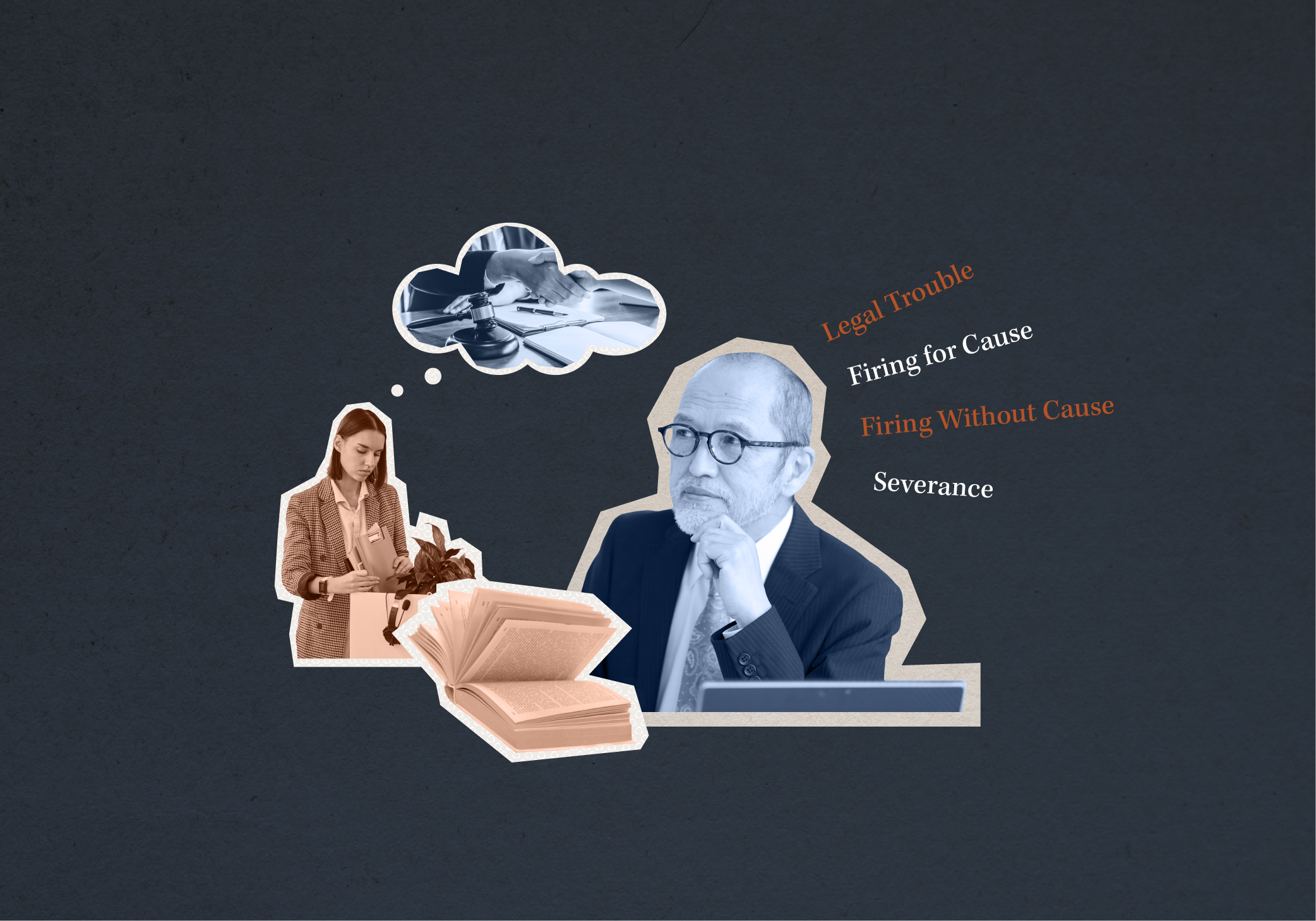Termination letters are an unfortunate part of running a business. Most people like to avoid conflict and would rather keep their employees on staff. From time to time, however, it becomes necessary to let an employee go, requiring a termination letter. They’re important documents, both legally and socially, so it’s critical to craft them correctly. Read on for information, advice, and examples.
What is a Termination Letter?
A termination letter, also known as a termination of employment letter or pink slip, is an official document that notifies an employee that they’ve been fired. It will include pertinent information on compensation, benefits due, and next steps (more on this below). Firing or laying off an employee is a major event and the details cannot be left to informal communication.
This blog should not be considered as legal advice. Some employers elect to consult an attorney when terminating an employee.
“If you deal with a lawyer, they’ll go the extra mile to protect you from risk,” says Goldbeck Recruiting President Henry Goldbeck.
Why are Termination Letters Important?

A termination letter serves several key functions.
· It provides structure and prevents misunderstandings, making it an important step to take, even if the termination has been discussed verbally. The obligations of both employer and employee are spelled out clearly and without ambiguity.
· It serves as a legal document, providing a written record of the termination and the reason behind it. It provides the employer with evidence that a fair and legal process has been followed. In cases where legal action is taken, the termination letter may be introduced as evidence.
· There is also an impact on corporate culture. A termination letter cannot mitigate the trauma that may be felt by the employee, but it should serve to provide clarity in an amicable format. Former employees talk, especially disgruntled ones. A well-executed document won’t stop this from happening, but could serve to minimize the damage.
Terminating With or Without Cause
Before writing the termination letter the organization must decide whether they are releasing the employee with or without cause. There are many potential reasons to dismiss an employee with cause, including misconduct, insubordination, chronic tardiness, or underperformance. In other instances the employee may be let go without cause, often as a result of downsizing or restructuring.
This distinction will have legal ramifications. Those let go without cause may be entitled to more severance. On the other hand, letting an employee go with cause may require the employer to demonstrate that there was indeed sufficient cause to warrant the termination.

Even in cases where there is justifiable cause for dismissal, it may not be in the employer’s best interest to terminate with cause. HR Expert Judy Slutsky advises clients to make the decision carefully.
“There’s a lot of paperwork required to let somebody go with cause,” she warns. “You could save yourself a month or two of severance, but if the person disputes the termination and the cause has not been clearly documented, the legal process can end up costing you more than the severance would have.”
What Should be Included in a Termination Letter?
If you’re wondering how to write a termination letter, there are several categories of information that should be included.
Top level information such as the employee name and ID number, the date of the termination, and the manager overseeing it should be included. Remember, this is a legal document and should read like one.
The reason for the termination is perhaps the most critical part, especially when an employee is being fired for cause. This should be detailed and demonstrate that a proper process has been followed. To the extent that you have documented verbal or written warnings, these should be outlined in the letter.
Details about pay, benefits, and next steps should also be provided. This includes the date of the employee’s final paycheck, vacation and severance pay forthcoming, as well as details about health insurance and other benefits. How and when payments will be made is important. In the event that a meeting or a more detailed document on these matters is forthcoming, the letter should state this.
Obligations of the employee should also be covered. This could include the return of company property or the deletion of company information from personal devices. If such steps have already been taken, the letter should note this.
Reminders about non-compete, non-disclosure, or other clauses impacting the terminated employee moving forward should also be mentioned.
Do your homework: Much of the process of writing a termination letter is done upfront. Before the first word of the letter is drafted, it’s important to gather all applicable information.
What Tone Should Termination Letters be Written In?
A termination letter should be straightforward and unambiguous, providing no room for misunderstanding. They should be professional and focussed, yet humane. The letter should not be overly harsh, but neither should it seek to read as a feel good letter. In the name of clarity, legalese should be avoided, but so, too, should jokes, informal talk, or unnecessary content.
“We use layman’s terms and a legally sanctioned template,” says Slutsky. “Our goal is to avoid escalating the issue with the employee who’s being terminated.”
Example of Termination Letter Without Cause
Slutsky provides us with an example of a termination letter without cause. Please note that this termination letter is not a legally binding document, but rather a notification to the Employee of termination of employment.
TERMINATION LETTER TEMPLATE (Without Cause)
PERSONAL AND CONFIDENTIAL
Employee Name
Home Address (Courier to the Employee home address, with a signature required)
OR C/O Company Name (if you deliver a hard copy of the termination letter to the Employee in person on the day of termination).
Date:
Re: Termination Employment
Dear Employee name,
This letter confirms our conversation today where we informed you that your employment with the “Company”) as (job title) has been terminated effective immediately (“Termination Date”) on a without cause basis.
You will receive all earned but unpaid salary and accrued but unpaid vacation pay to the Termination Date.
Final payment should be made within 48 hours of termination
Identify how payment will be issued i.e. Your final pay statement will be available either through the Company online payroll system or mailed to your home address
Pay in lieu of notice specified in the Employment Contract
If providing the minimum required pay based on BC Employment Standards: In addition, pursuant to section X of your Employment Contract with (Company name) dated (date) and the BC Employment Standards Act, you will receive (X week’s pay in lieu of notice of termination).
If the Employment Contract specifies a schedule of termination pay in lieu of notice based on employment period – specify the amount of payment here.
If the Employment Agreement outlined commission for this position: You will also receive any commission payments owing to you, according to the terms and conditions set out in the Employment Agreement regarding commission payments on termination of employment.
All of the above amounts are subject to applicable statutory deductions and withholdings.
Record of Employment
We will be issuing your record of employment (ROE) shortly (specify where and when the ROE can be accessed: ROE can be accessed via Services Canada online, payroll system online, or mailed to your home address.)
Group Health Benefits
Your eligibility for benefits coverage will end on the Termination Date. You may be able to convert some group coverage to individual coverage—if you wish to do so, you must contact the insurer directly within (X) days of cessation of coverage.
Company Expenses
If you have any unpaid expenses, please submit them by no later than (date) and the Company will reimburse them by (date).
Company Property
Please also return all Company property on the Termination Date including smartphone, computer hardware, computer records, computer passwords, keys, access cards, files, data and other documentation or records, in any form whatsoever, including all copies thereof. We also ask that you provide us with a written list of websites and/or passwords used in the course of conducting business on our behalf.
Employee Obligations
In accordance with the terms of the Employment Agreement, we want to remind you of your ongoing obligations: list here
Confidentiality
We remind you of your ongoing legal obligation not to disclose any confidential information of the Company, which obligation continues indefinitely.
Non-Solicitation (if included in the Employment Agreement)
We remind you of your legal obligation to not solicit or persuade any employee, contractor or customer of the Company to end their employment or engagement, as the case may be, with the Company.
Employee name, We sincerely thank you for your contributions and wish you the best of luck in your future endeavors.
Sincerely,
Company Name
Signed by:
HR Representative
Direct Manager
Senior Leadership
Cc: Employee Personnel File
Termination Letter With Cause
In the event that the termination is with cause, there should be a section included in the termination letter that details the cause. This could include poor performance, attendance, or a violation of a specific policy. To the extent possible, each infraction should be noted, along with dates. The process which resulted in the termination should also be documented, including warnings, reminders, appraisals, training, and investigations. You may also wish to provide an overview of the impact of the employee’s behaviour on the company and other staff.
Terminating with cause may also alter other aspects of the termination, such as severance pay due. HR or legal should be consulted, and the payment and benefits sections of the termination letter should be altered accordingly.
Ultimately, the termination letter is a cursory document that injects clarity into an emotional event. Before the letter itself is crafted, decisions must be made that have human consequences.
“Companies must decide what they want to do based on their corporate culture and the way they want to treat people,” says Goldbeck. “Do you want to offer the bare minimum, or do you want to do more than that?” Your company’s reputation is worth the extra mile when terminations become necessary.




